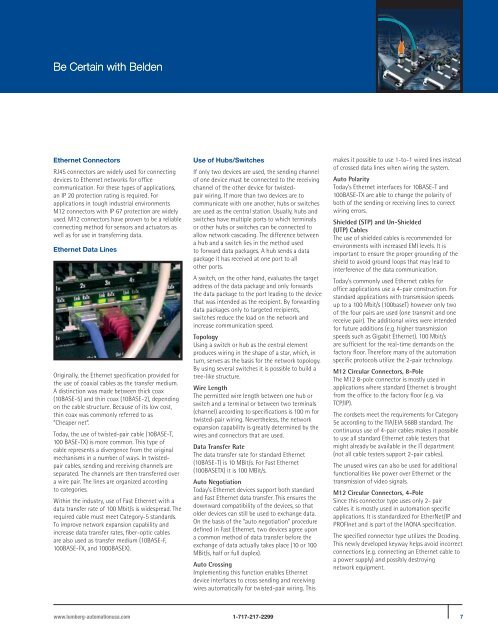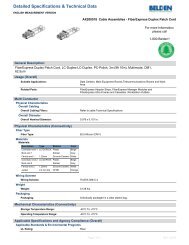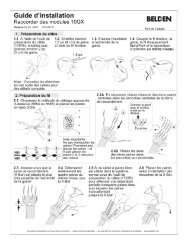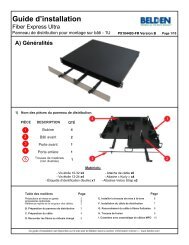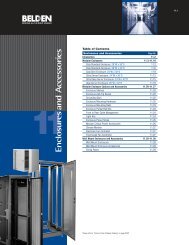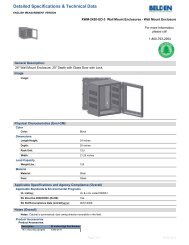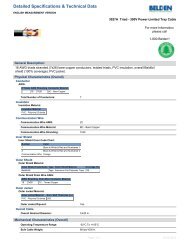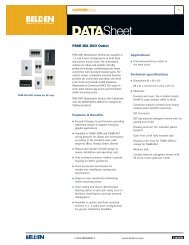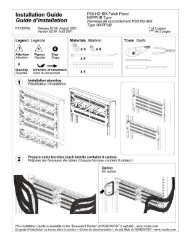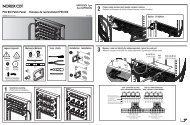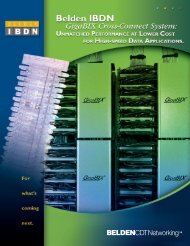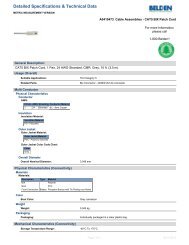PROFINET®,EtherNet/IP, and Ethernet Connectivity Solutions - Belden
PROFINET®,EtherNet/IP, and Ethernet Connectivity Solutions - Belden
PROFINET®,EtherNet/IP, and Ethernet Connectivity Solutions - Belden
Create successful ePaper yourself
Turn your PDF publications into a flip-book with our unique Google optimized e-Paper software.
Be Certain with <strong>Belden</strong><br />
<strong>Ethernet</strong> Connectors<br />
RJ45 connectors are widely used for connecting<br />
devices to <strong>Ethernet</strong> networks for office<br />
communication. For these types of applications,<br />
an <strong>IP</strong> 20 protection rating is required. For<br />
applications in tough industrial environments<br />
M12 connectors with <strong>IP</strong> 67 protection are widely<br />
used. M12 connectors have proven to be a reliable<br />
connecting method for sensors <strong>and</strong> actuators as<br />
well as for use in transferring data.<br />
<strong>Ethernet</strong> Data Lines<br />
Originally, the <strong>Ethernet</strong> specification provided for<br />
the use of coaxial cables as the transfer medium.<br />
A distinction was made between thick coax<br />
(10BASE-5) <strong>and</strong> thin coax (10BASE-2), depending<br />
on the cable structure. Because of its low cost,<br />
thin coax was commonly referred to as<br />
“Cheaper net”.<br />
Today, the use of twisted-pair cable (10BASE-T,<br />
100 BASE-TX) is more common. This type of<br />
cable represents a divergence from the original<br />
mechanisms in a number of ways. In twistedpair<br />
cables, sending <strong>and</strong> receiving channels are<br />
separated. The channels are then transferred over<br />
a wire pair. The lines are organized according<br />
to categories.<br />
Within the industry, use of Fast <strong>Ethernet</strong> with a<br />
data transfer rate of 100 Mbit/s is widespread. The<br />
required cable must meet Category-5 st<strong>and</strong>ards.<br />
To improve network expansion capability <strong>and</strong><br />
increase data transfer rates, fiber-optic cables<br />
are also used as transfer medium (10BASE-F,<br />
100BASE-FX, <strong>and</strong> 1000BASEX).<br />
Use of Hubs/Switches<br />
If only two devices are used, the sending channel<br />
of one device must be connected to the receiving<br />
channel of the other device for twistedpair<br />
wiring. If more than two devices are to<br />
communicate with one another, hubs or switches<br />
are used as the central station. Usually, hubs <strong>and</strong><br />
switches have multiple ports to which terminals<br />
or other hubs or switches can be connected to<br />
allow network cascading. The difference between<br />
a hub <strong>and</strong> a switch lies in the method used<br />
to forward data packages. A hub sends a data<br />
package it has received at one port to all<br />
other ports.<br />
A switch, on the other h<strong>and</strong>, evaluates the target<br />
address of the data package <strong>and</strong> only forwards<br />
the data package to the port leading to the device<br />
that was intended as the recipient. By forwarding<br />
data packages only to targeted recipients,<br />
switches reduce the load on the network <strong>and</strong><br />
increase communication speed.<br />
Topology<br />
Using a switch or hub as the central element<br />
produces wiring in the shape of a star, which, in<br />
turn, serves as the basis for the network topology.<br />
By using several switches it is possible to build a<br />
tree-like structure.<br />
Wire Length<br />
The permitted wire length between one hub or<br />
switch <strong>and</strong> a terminal or between two terminals<br />
(channel) according to specifications is 100 m for<br />
twisted-pair wiring. Nevertheless, the network<br />
expansion capability is greatly determined by the<br />
wires <strong>and</strong> connectors that are used.<br />
Data Transfer Rate<br />
The data transfer rate for st<strong>and</strong>ard <strong>Ethernet</strong><br />
(10BASE-T) is 10 MBit/s. For Fast <strong>Ethernet</strong><br />
(100BASETX) it is 100 MBit/s.<br />
Auto Negotiation<br />
Today’s <strong>Ethernet</strong> devices support both st<strong>and</strong>ard<br />
<strong>and</strong> Fast <strong>Ethernet</strong> data transfer. This ensures the<br />
downward compatibility of the devices, so that<br />
older devices can still be used to exchange data.<br />
On the basis of the “auto negotiation” procedure<br />
defined in Fast <strong>Ethernet</strong>, two devices agree upon<br />
a common method of data transfer before the<br />
exchange of data actually takes place (10 or 100<br />
MBit/s, half or full duplex).<br />
Auto Crossing<br />
Implementing this function enables <strong>Ethernet</strong><br />
device interfaces to cross sending <strong>and</strong> receiving<br />
wires automatically for twisted-pair wiring. This<br />
makes it possible to use 1-to-1 wired lines instead<br />
of crossed data lines when wiring the system.<br />
Auto Polarity<br />
Today’s <strong>Ethernet</strong> interfaces for 10BASE-T <strong>and</strong><br />
100BASE-TX are able to change the polarity of<br />
both of the sending or receiving lines to correct<br />
wiring errors.<br />
Shielded (STP) <strong>and</strong> Un-Shielded<br />
(UTP) Cables<br />
The use of shielded cables is recommended for<br />
environments with increased EMI levels. It is<br />
important to ensure the proper grounding of the<br />
shield to avoid ground loops that may lead to<br />
interference of the data communication.<br />
Today’s commonly used <strong>Ethernet</strong> cables for<br />
office applications use a 4-pair construction. For<br />
st<strong>and</strong>ard applications with transmission speeds<br />
up to a 100 Mbit/s (100baseT) however only two<br />
of the four pairs are used (one transmit <strong>and</strong> one<br />
receive pair). The additional wires were intended<br />
for future additions (e.g. higher transmission<br />
speeds such as Gigabit <strong>Ethernet</strong>). 100 Mbit/s<br />
are sufficient for the real-time dem<strong>and</strong>s on the<br />
factory floor. Therefore many of the automation<br />
specific protocols utilize the 2-pair technology.<br />
M12 Circular Connectors, 8-Pole<br />
The M12 8-pole connector is mostly used in<br />
applications where st<strong>and</strong>ard <strong>Ethernet</strong> is brought<br />
from the office to the factory floor (e.g. via<br />
TCP/<strong>IP</strong>).<br />
The cordsets meet the requirements for Category<br />
5e according to the TIA/EIA 568B st<strong>and</strong>ard. The<br />
continuous use of 4-pair cables makes it possible<br />
to use all st<strong>and</strong>ard <strong>Ethernet</strong> cable testers that<br />
might already be available in the IT department<br />
(not all cable testers support 2-pair cables).<br />
The unused wires can also be used for additional<br />
functionalities like power over <strong>Ethernet</strong> or the<br />
transmission of video signals.<br />
M12 Circular Connectors, 4-Pole<br />
Since this connector type uses only 2- pair<br />
cables it is mostly used in automation specific<br />
applications. It is st<strong>and</strong>ardized for <strong>EtherNet</strong>/<strong>IP</strong> <strong>and</strong><br />
PROFInet <strong>and</strong> is part of the IAONA specification.<br />
The specified connector type utilizes the Dcoding.<br />
This newly developed keyway helps avoid incorrect<br />
connections (e.g. connecting an <strong>Ethernet</strong> cable to<br />
a power supply) <strong>and</strong> possibly destroying<br />
network equipment.<br />
www.lumberg-automationusa.com 1-717-217-2299 7


